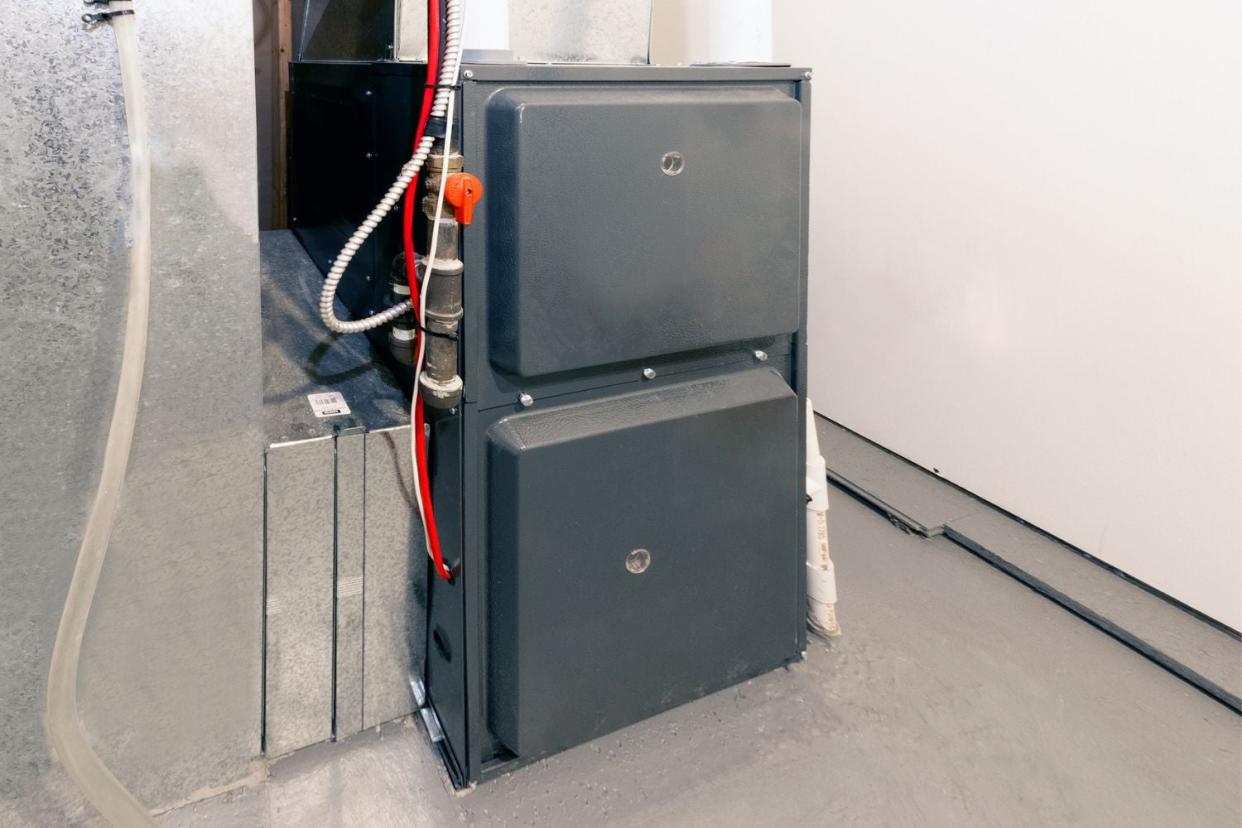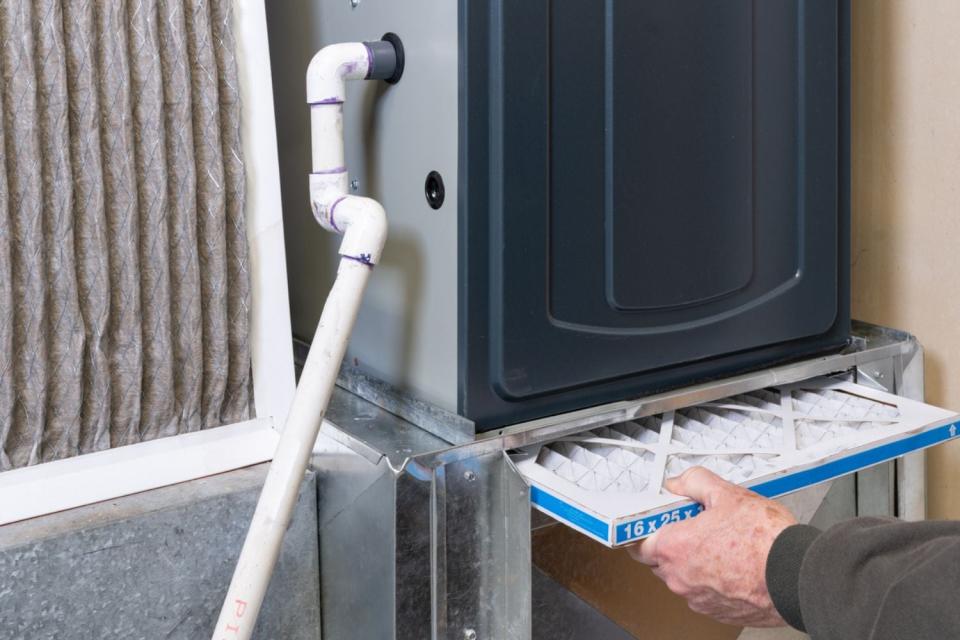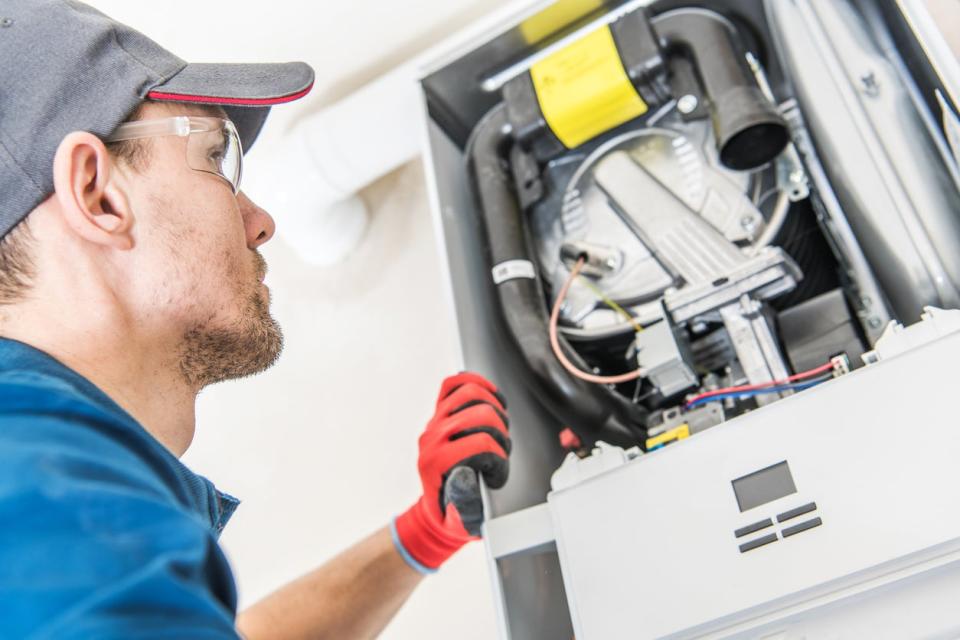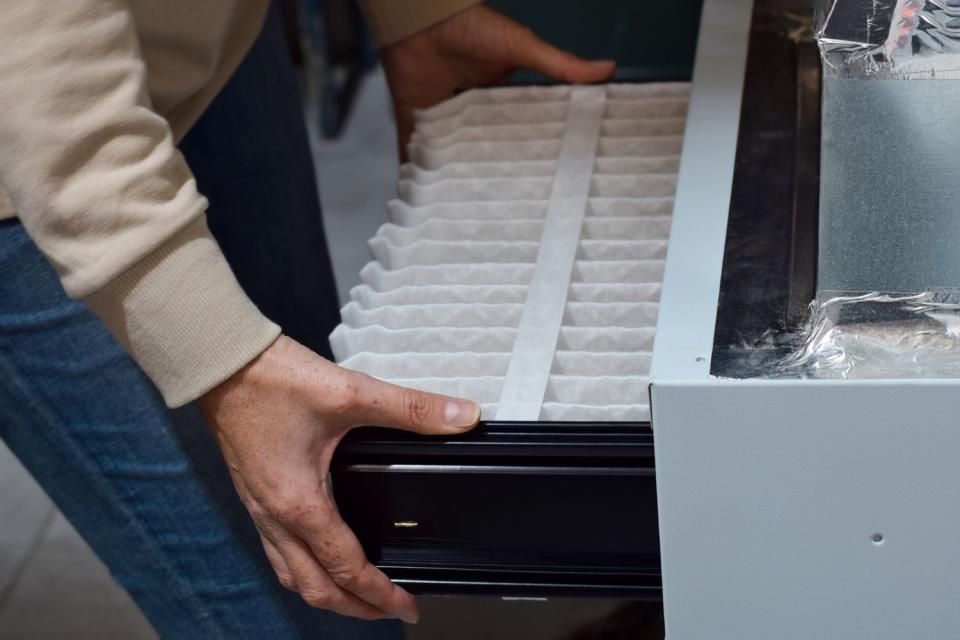How Much Does Heat Exchanger Replacement Cost?

Highlights
The average heat exchanger replacement cost is $1,500, but the range is typically $1,000 to $2,000.
The furnace size, age, and brand as well as the number of heat exchangers in the unit will all affect the cost of replacing a heat exchanger. Labor, permits, warranties, and other needed repairs will affect the cost as well.
For safety purposes, homeowners are advised to prioritize immediate repairs when they notice visible soot, clicking noises, carbon monoxide alerts, bad odors, or leaking water or when they have an aging furnace.
While homeowners can be proactive about replacing a furnace’s filters and cleaning vents, replacing critical components such as a heat exchanger is a job for licensed and certified professionals who follow safety protocols and best practices that ultimately keep the home’s occupants safe.
Heat exchanger replacement is an important part of maintaining an HVAC system for a comfortable and energy-efficient home. While furnaces can often be taken for granted, it’s important for homeowners to remember that the system requires regular maintenance and occasional replacement of certain parts.
What is a heat exchanger? According to Mark Snell, CEO and president of Polestar Plumbing, Heating & Air Conditioning in Merriam, Kansas, “The heat exchanger plays a crucial role in regulating indoor air temperature and quality. Its primary function is to transfer heat between two fluids or gases without mixing them.” The heat exchanger is a network of metal tubes or coils designed to maximize the surface area available for heat transfer. This item is an essential part of every gas, oil, or propane furnace, fireplace, or HVAC system.
The cost of heat exchanger replacement can vary due to the type of heat exchanger; the furnace size, age, and brand; furnace accessibility; and local labor costs. According to HomeAdvisor, heat exchanger replacement cost ranges from $1,000 to $2,000, with many homeowners spending $1,500 for parts and labor.

Photo: istockphoto.com
Factors in Calculating Heat Exchanger Replacement Cost
There are various types of heat exchangers, such as plate heat exchangers, fireplace heat exchangers, and boiler heat exchangers. Each type may require different materials and labor hours, which can affect the overall cost. Other factors that determine heat exchanger replacement cost can also include the size and age of the furnace, the furnace brand, the accessibility of the furnace, and local labor rates.
Furnace Size and Age
Furnace size is determined by its BTU (British Thermal Unit) rating, which measures the amount of heat it produces. Larger furnaces have bigger heat exchangers in order to produce the amount of heat that’s needed for a larger home. Typically, the larger the heat exchanger, the more expensive the replacement cost.
“The age of a furnace indeed plays a significant role in the cost and decision-making process regarding heat exchanger replacement, and in some cases, it can influence the decision to replace the entire furnace,” explains Snell.
Between 15 and 20 years is about how long a furnace lasts, but as it ages, a heat exchanger can develop cracks or corrode, which can decrease the overall efficiency and safety of the unit. If a furnace is relatively new, a homeowner may receive a discounted or free heat exchanger as part of the warranty. If the furnace is much older and the warranty on parts has run out, a homeowner will have to pay for the full price of a replacement.
“If your furnace is approaching or has surpassed this age range, it might be more economical in the long run to replace the entire unit rather than investing in significant repairs,” explains Snell. “Moreover, older furnaces are generally less efficient than modern units. Upgrading to a new, more energy-efficient model can lead to savings on energy bills and provide better heating performance.”
It’s usually more expensive to find replacement parts for older furnaces, which can drive up the heat exchanger price. HVAC repair professionals may also charge more to replace a cracked heat exchanger in an old furnace since it can take much longer to work on an aging heating system—not to mention they may find other worn-out parts that need attention.
Furnace Brand
Different furnace brands have different pricing structures, availability of parts, and overall quality, which can all contribute to the replacement cost of a heat exchanger. The replacement parts from one of the best furnace brands may be more available than from lesser-known brands.
The quality and durability of the furnace brand can also affect the heat exchanger replacement cost. Finding out how the cost to replace a heat exchanger is directly related to the furnace brand can give homeowners an idea of what they can expect to budget for the replacement.
Furnace Brand | Average Cost (Unit Only) |
$340 to $800 | |
$350 to $800 | |
$260 to $860 | |
$320 to $860 | |
$260 to $840 | |
$290 to $800 | |
$320 to $825 | |
$470 to $800 |
Accessibility
One often overlooked factor that can affect the cost of heat exchanger replacement is the accessibility of the furnace. When a furnace is in a hard-to-reach location, like a crawlspace or an attic, it can be challenging for HVAC technicians to remove and replace the broken parts. This can result in higher labor costs since it’s more challenging to work in a tight space.
Labor
The process to replace a heat exchanger is time-consuming. The cost of labor can vary depending on the complexity of the job, the location of the furnace, the market demand for replacement services, and the local cost of living. Labor prices to replace a heat exchanger typically costs from $75 to $125 per hour, and it’s common for the replacement job to take between 5 and 8 hours. The technician needs to take apart and reassemble the entire furnace to replace the heat exchanger, which is not a short process. An emergency replacement could cost from $140 to $210 per hour since after-hours service calls typically cost more than standard calls.
Labor prices to replace a heat exchanger typically range from $400 to $600. It’s recommended that homeowners replace a heat exchanger only if the furnace is less than 10 years old and there are no other issues with or damage to the unit. If the cost of replacing a gas furnace heat exchanger exceeds the cost of buying a new furnace, an entire furnace replacement might make more financial sense.
Additional Costs and Considerations
When budgeting for heat exchanger replacement cost, homeowners may discover additional price factors and considerations that can alter the total price. These factors can include the cost difference between replacing a primary vs. secondary heat exchanger, permit fees, any warranties on the existing unit, and any other needed furnace repairs.
Primary vs. Secondary Heat Exchanger
Most high-efficiency furnaces use two heat exchangers, which will increase the price when it’s time to replace them. The primary heat exchanger extracts the heat from the combustion process, and the secondary one further draws out any remaining heat from the gases before they’re vented out of the heating unit.
“The simplest way to determine whether a furnace has one or two heat exchangers is to check the user manual or specification sheet,” says Snell. “Usually, it provides information about its components, including the number of heat exchangers. If the manual is not available, you can use the model number, typically found on a label on the furnace, to look up this information online. If you're in doubt, it's always best to consult with a licensed HVAC technician. They can easily identify the type of furnace and the number of heat exchangers during a routine inspection or maintenance visit.”
The main heat exchanger can cost from $350 to $850 for the part alone, depending on the furnace size and brand. Replacing a secondary heat exchanger costs between $300 and $800 for the part and between $1,000 and $2,000 with labor included. The total cost of replacement depends on the furnace capacity, material, and brand.
“[If] you have an older model furnace, it's more likely to have a single heat exchanger,” says Snell. “Conversely, if you've recently installed a new high-efficiency furnace, it's more likely to have two heat exchangers. If it's accessible and safe, you can visually inspect the furnace. In a two-exchanger system, you might see two distinct chambers or sections. However, this might not always be apparent without technical knowledge.”
Permits
The actual cost of a permit can vary depending on the geographic location and complexity of the project. Some municipalities may charge a flat fee for HVAC permits, while others will base the fee on the type and extent of the project. It’s recommended that homeowners double-check to make sure a permit is needed to replace a furnace heat exchanger. If the local government requires a permit, the average cost is generally around $150.
Furnace Warranty
The cost to replace a furnace heat exchanger can vary depending on whether the unit is covered by a warranty. If the warranty is still valid, the repair cost can be discounted or potentially free to the homeowner. Most furnace companies offer 10- to 20-year warranties that cover various parts of the system. If a heat exchanger breaks during this time, the manufacturer will typically replace it at no additional cost to the homeowner. Labor costs are not usually covered, so the homeowner may be responsible for paying the technician for their time and effort.
Additional Furnace Repairs
If the furnace needs repairs in addition to replacement of the heat exchanger, the project will cost more. On average, furnace repair costs range from $131 to $486, with more significant repairs costing $1,250 or more. Homeowners will want to weigh the cost of repairs along with the cost of the heat exchanger replacement to determine if the investment is worth it. If the overall price of repairs is more than half of what the furnace is worth, it might make better financial sense to buy a new furnace.

Photo: istock.com
Heat Exchanger Replacement Cost by Type of Furnace
The cost to replace a heat exchanger can vary depending on the type of furnace—whether it’s a boiler, commercial, high-efficiency, or standard furnace. Understanding how heat exchanger replacement cost is connected to the furnace type can help homeowners plan their budget.
To determine the best heating option for their home, homeowners can consider the differences between an electric furnace vs. gas. To make sure either type of furnace stays in good condition, homeowners will want to hire qualified professionals to perform regular maintenance and inspections. If homeowners are looking for alternatives to electric or gas furnaces, geothermal heating systems are another option.
Boiler
Boiler furnaces use hot water to produce warmth, whereas HVAC systems produce forced air to heat a space. The heat exchanger in a boiler is usually larger than other types, with a more intricate design. Replacing a heat exchanger in a boiler furnace can cost from $100 to $300 on average, not including labor. Since modern boilers have two heat exchangers, they are more energy efficient.
Commercial
Commercial or industrial heat exchangers can be replaced at a cost between $1,500 and $5,000. The overall price depends on factors such as the size, brand, type, and BTU rating of the furnace. Commercial furnaces tend to be very powerful, with larger heat exchangers to accommodate the areas within the property.
High-Efficiency
High-efficiency furnaces have two heat exchangers that extract more heat from the combustion process. Replacing these can run between $300 and $800 since they’re more complex than the ones found in a standard furnace.
Standard
As the name suggests, standard furnaces are the most common type of furnaces found in homes. They are typically less expensive than high-efficiency models, and their HVAC heat exchangers are often less expensive to replace. Homeowners typically pay between $100 and $300 for replacement, but the overall price depends on the furnace type, age, accessibility, and local labor rates.
Do I need a heat exchanger replacement?
It’s recommended that homeowners hire a professional to inspect their furnace on a regular basis. Without technicians to keep an eye on furnace wear and tear, homeowners may not recognize the signs that the heat exchanger may be damaged and in need of a replacement. Fortunately, there are several key signs the home’s occupants can watch for.
Soot in the Furnace
“If you suspect problems with the heat exchanger, it is important to inspect the inside of the furnace for the presence of soot,” says Snell. “This can be a signal of incomplete combustion, often due to a malfunctioning heat exchanger.”
Soot in a furnace is a clear indicator that a heat exchanger needs to be replaced. Since a heat exchanger’s job is to transfer heat produced by the furnace’s burner and separate it from the combustion gases, the accumulation of soot inside the furnace is a sign that the heat exchanger is not working properly. A cracked or broken heat exchanger can allow carbon monoxide to enter the home instead of being safely vented outside.
Clicking Noises
Over time, a heat exchanger can become worn out or damaged due to the constant use and exposure to high temperatures inside the furnace. The metal can crack, or holes can form, both of which allow carbon monoxide to escape into the home. Clicking or popping sounds happen when the heat exchanger material expands and contracts as it heats up and cools down. This clicking is a red flag that heat exchanger repair or replacement is needed.
“Additionally, if you hear rattling or banging noises coming from the furnace, it can also signal a problem with the heat exchanger,” says Snell. “These sounds may result from expansion and contraction caused by cracks or structural weaknesses.”
Corrosion
It’s normal for a heating unit to corrode at the end of its lifespan. Corrosion leads to rust, which weakens the heat exchanger and prevents it from working properly. As corrosion eats away at the metal, it creates holes and cracks, which can allow toxic gases to escape. If a homeowner detects corrosion in their furnace, it’s a good sign that a technician needs to come replace the heat exchanger.
Carbon Monoxide Alarm
A carbon monoxide alarm going off is a major warning sign that a furnace’s heat exchanger is not working properly and needs immediate attention. Since carbon monoxide is a colorless, odorless, and highly toxic gas that can cause severe health issues or death, an early-detection alarm is beneficial to the safety of everyone in the home. If a carbon monoxide alarm goes off, it’s an urgent sign that there is something wrong with the furnace.
Unpleasant Odor
Unpleasant odors can also be a sign that a heat exchanger is cracked or damaged. One common odor is the smell of formaldehyde, which is produced during the heating and cooling process. Other times the home’s residents may smell rotten eggs, which is a sign of a gas leak. Ignoring the problem or trying to cover the odor with air fresheners is not recommended, since any gas leaks pose a danger to the home’s occupants.
Leaking Water
Water is created in a furnace via the combustion process. Water on the floor around the furnace is another sign of a bad heat exchanger.
“The most definitive sign of an issue is the presence of visible cracks or holes in the heat exchanger,” explains Snell. “One of the indicators of these cracks is water pooling around the furnace.”
Aging Furnace
If a furnace is over 8 years old, it’s important for homeowners to keep an eye on the condition of the individual parts and replace them as soon as they need attention. Scheduling regular maintenance visits can prolong the lifespan of a homeowner’s furnace and help prevent emergency repairs.
“If the furnace is old, finding replacement parts like a heat exchanger can be more challenging and potentially more expensive,” explains Snell. “Additionally, the cost of labor and parts might not be justifiable for an older unit that is nearing the end of its lifespan. If your furnace requires frequent repairs, this is a strong indication that it's time to consider a replacement. Ongoing maintenance costs can quickly add up, making a new furnace a more financially sound decision.”

Photo: istockphoto.com
Heat Exchanger Replacement: DIY vs. Hiring a Professional
While it may be tempting to tackle the job of replacing a heat exchanger to save on labor costs, this is not recommended as a DIY project. Heat exchanger replacement is a complex and challenging job that requires a specific skill set and proper licensing. If a homeowner doesn’t have the experience or the correct tools, they can damage their furnace and run the risk of injury or carbon monoxide leaks.
“[Replacing a heat exchanger] demands a deep understanding of furnace operation, adherence to safety protocols, and strict adherence to specific manufacturer guidelines,” warns Snell. “Attempting DIY repairs can result in the voiding of existing warranties on your furnace. Furthermore, incorrect installation can pose serious safety hazards, including carbon monoxide leaks, fire risks, and inefficient furnace operation. “
Professional HVAC technicians have the skills and experience to handle heat exchanger replacements and ensure the job is done right. By hiring a professional with the proper certifications and state and local licenses, homeowners can rest assured that all safety standards and requirements will be followed.
“As an added benefit, hiring professionals allows them to assess the overall health of your furnace and identify any other potential issues, ensuring that the entire system is in good working order,” explains Snell. “Their expertise in ensuring efficient operation can prevent future repairs and extend the life of your furnace, ultimately saving you money in the long run.”
How to Save Money on Heat Exchanger Replacement Cost
Replacing a heat exchanger can be expensive, but there are a few ways homeowners can save money on replacement cost. By following these helpful tips, they can keep their expenses on the lower end of the average cost.
Get multiple estimates. Homeowners will want to get at least three estimates from reputable local HVAC professionals to find a price that works with their budget.
Perform regular maintenance. Regular maintenance and inspections can help identify any potential issues with a heat exchanger.
Look at the warranty. If the furnace is still covered by a warranty, it’s recommended that homeowners check to see if a heat exchanger replacement is included. A warranty could save on the cost of parts and, in some cases, on the cost of labor too.
Perform DIY tasks. While replacing a heat exchanger is a job for the pros, homeowners can replace filters and clean the heating unit to help improve the performance and extend the life of the furnace.
Consider an upgrade. If the furnace is older and has more issues than just a heat exchanger replacement, homeowners are advised to consider upgrading their furnace or HVAC system. While the upfront cost may be expensive, homeowners can save money by having lower monthly utility bills with an energy-efficient model.
Purchase a home warranty. Buying a warranty from one of the best home warranty companies (such as American Home Shield or AFC Home Club) can help homeowners save on the cost of replacing costly appliances and whole-home systems, such as plumbing, electricity, HVAC units, and even heat exchangers.
Questions to Ask About Heat Exchanger Replacement
Asking an HVAC professional the right questions can help homeowners gain a better understanding of the process involved in replacing a heat exchanger and help avoid miscommunication.
How long have you been working on furnaces?
Do you offer free estimates?
Can you walk me through the furnace inspection process?
Does the furnace inspection also include looking at the ducts and flue pipe?
What recommendations do you have regarding furnace repairs?
Are you licensed and insured?
What certifications do you have?
Will you provide a written estimate?
Can you provide references?
Do you have testimonials from previous customers?
Do you use original manufacturer parts?
What is the expected lifespan of the replacement heat exchanger?
How long will the replacement take?
Will you do a combustion analysis to test for carbon monoxide leaks?
Are there any additional costs that aren’t included in the pricing estimate?
How can I keep my furnace in good condition and improve the air quality in my home?
Do you offer any warranties or guarantees for parts and labor?
Do you offer a furnace maintenance plan?
How much longer do you think my furnace will last?
Will you provide a written list of the repairs and replacements?
How can I leave a review of your work?
FAQs
Many homeowners who need to replace their heat exchanger are often unsure of the cost and the replacement process. They can use these answers to some frequently asked questions about the most expensive part to replace in a furnace, heat exchanger lifespan, the importance of a heat exchanger, and the time it takes to replace a heat exchanger. Understanding these aspects can help homeowners make an informed decision and budget properly.
Q. What is the most expensive part to replace in a furnace?
Some of the most expensive parts to replace in a furnace include a draft inducer motor at $1,500, a heat exchanger at an average of $1,500, and a blower motor at $2,000.
Q. How long does a heat exchanger last in a furnace?
Heat exchangers can last between 10 and 20 years depending on the quality and usage of the part and the quality of the furnace maintenance.
Q. How important is a heat exchanger in a furnace?
A heat exchanger is a vital component in a furnace. It needs to have an airtight seal to prevent toxic gases from entering a home.
“In the context of heating, a furnace's heat exchanger transfers heat from the combustion gases to the air blown through the building's ducts,” explains Snell. “This efficient process warms indoor air by utilizing the heat generated from burning fuel. The design ensures the separation of combustion gases and indoor air, thereby maintaining air quality and safety.
In cooling systems, such as air conditioners or refrigeration units, the heat exchanger operates in the reverse direction. It extracts heat from indoor air and releases it outside. Typically, this is achieved using a refrigerant fluid that absorbs indoor heat and expels it outdoors through the heat exchanger.”
Q. How long does it take to replace a heat exchanger?
Heat exchanger replacement can take between 5 and 8 hours, depending on the complexity of the job, the furnace type, and the experience of the technician.
Sources: HomeAdvisor, HomeGuide, Forbes, Today’s Homeowner

